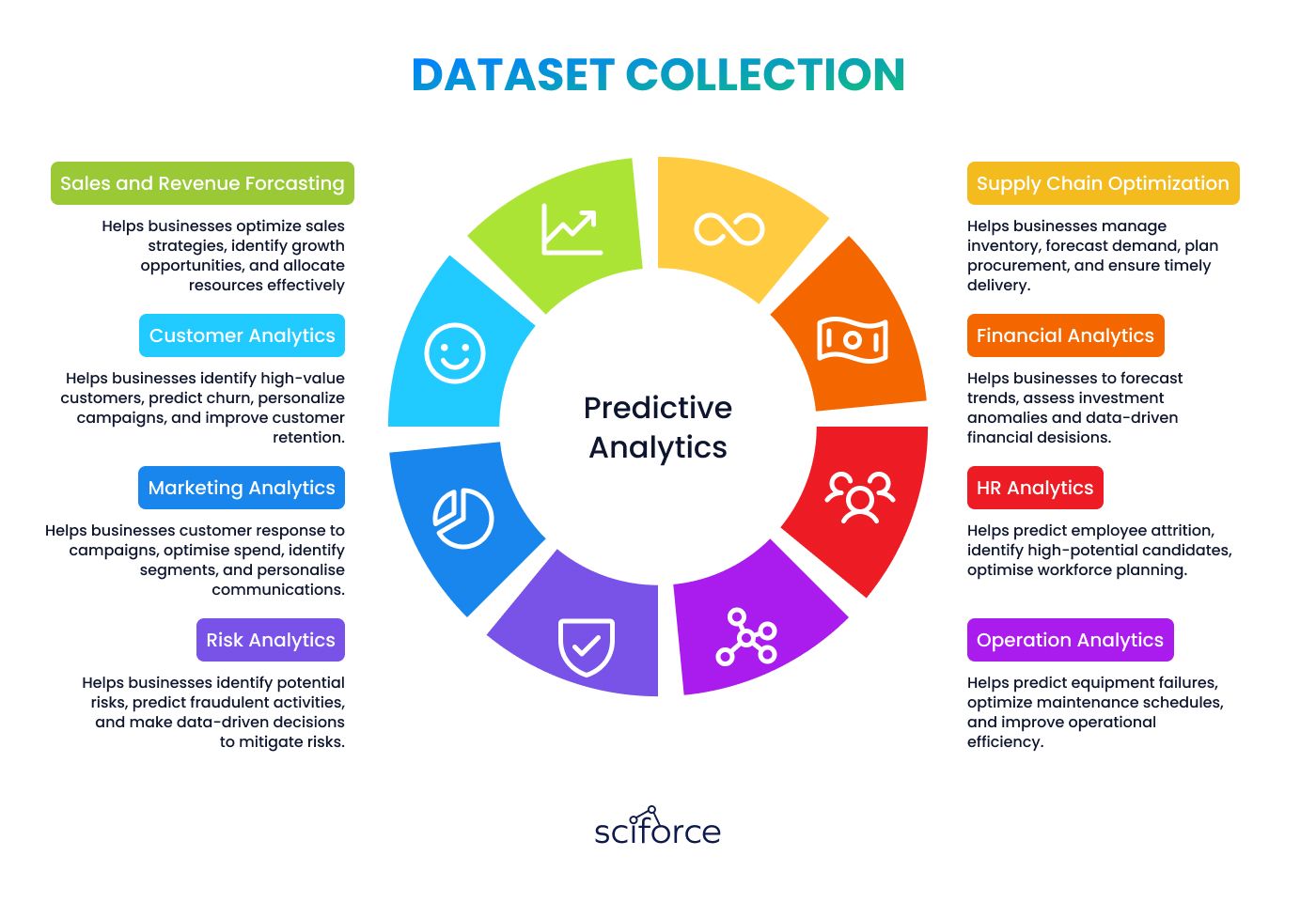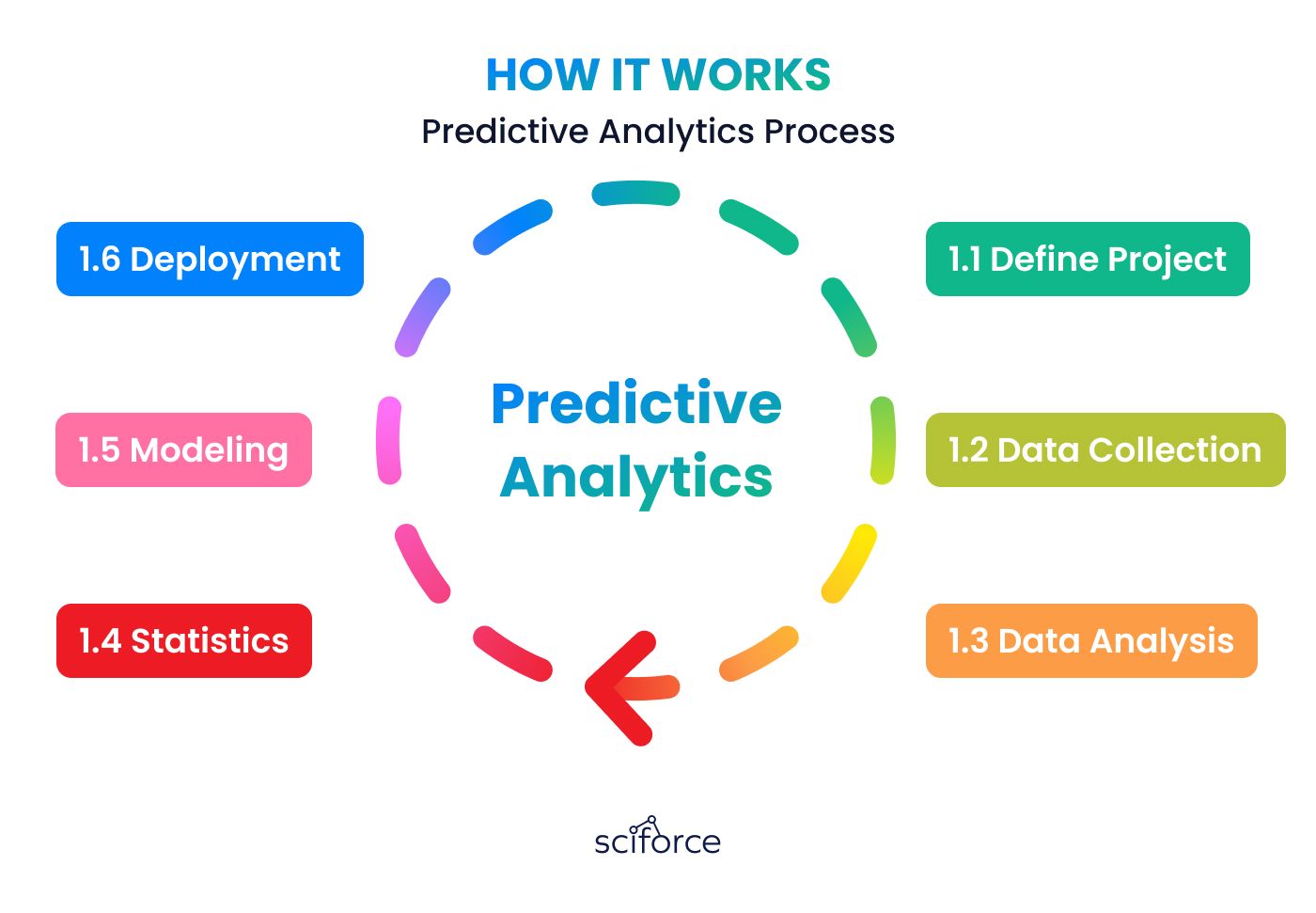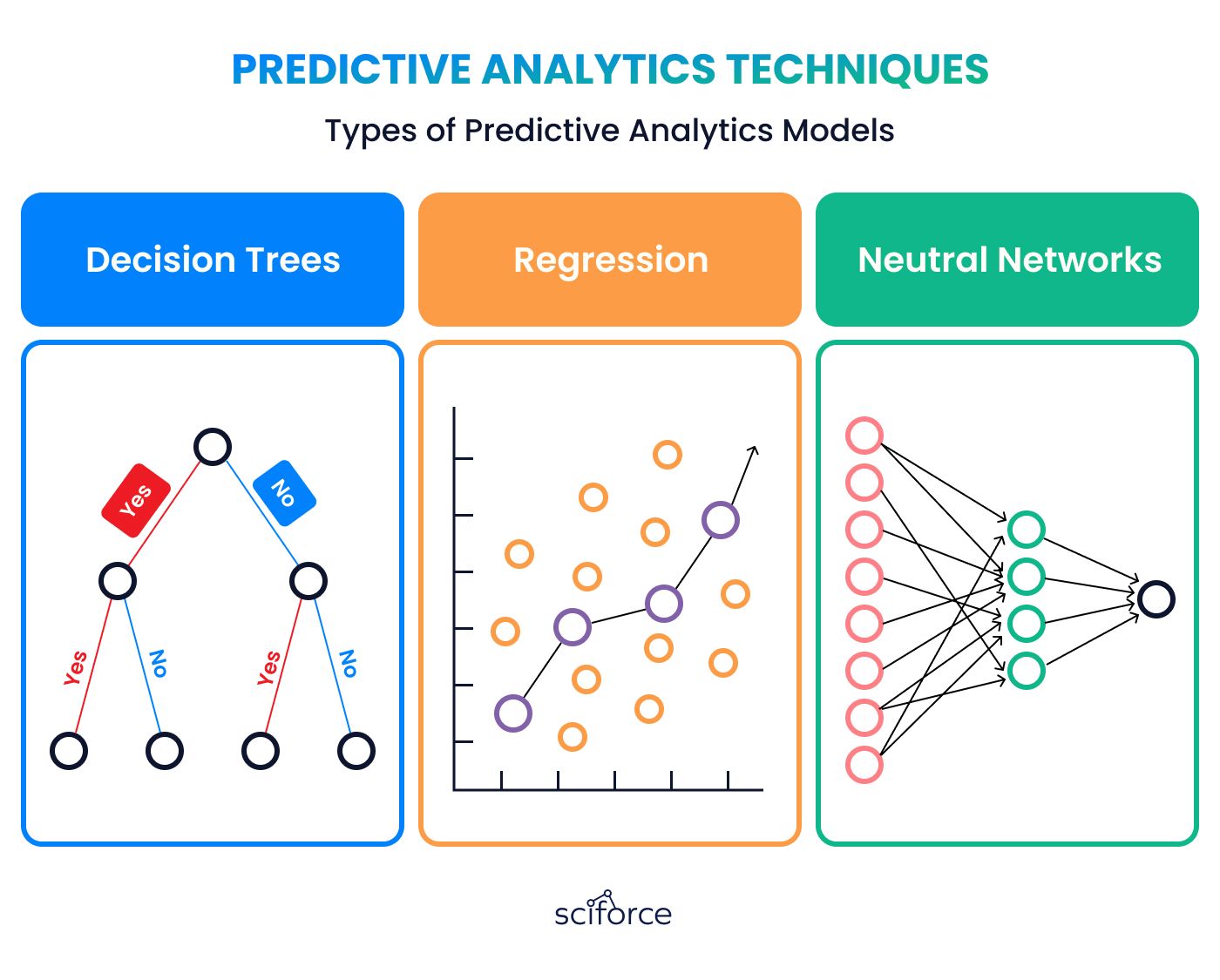Predictive analytics uses historical data and techniques like statistical modeling and machine learning to predict future outcomes. It provides accurate forecasts, helping organizations predict trends and behaviors from milliseconds to years ahead.
The global predictive analytics market was valued at 14.71 billion U.S. dollars in 2023 and is projected to grow from 18.02 billion U.S. dollars in 2024 to 95.30 billion U.S. dollars by 2032, with a compound annual growth rate (CAGR) of 23.1% during the forecast period (2024-2032).
80% of business leaders recognize that data is crucial for understanding operations, customers, and market dynamics. By combining historical data with predictive models, businesses gain a comprehensive view of their data, enabling real-time predictions and proactive responses to changing conditions. This article covers the basics of predictive analytics, how it works, its benefits, types of models, and key use cases in various industries.
Predictive analytics enables organizations to identify patterns in data to detect risks and opportunities. By designing models that reveal relationships between various factors, organizations can assess the potential benefits or risks of specific conditions, supporting informed decision-making.

Improved Decision-Making
Provides detailed data-driven insights, such as customer buying patterns and market trends.
Increased Efficiency
Streamlines operations by identifying bottlenecks in production lines and optimizing supply chain logistics.
Cost Reduction
Identifies specific areas, like energy usage and inventory management, where costs can be cut without compromising the quality.
Risk Management
Detects potential risks, such as fraud in financial transactions or equipment failures in manufacturing.
Enhanced Customer Experience
Uses predictive insights to tailor marketing campaigns, recommend products, and customize services.

Data Collection
Historical data is collected from sources such as transaction records, customer interactions, and sensor data.
Data Cleaning and Preparation
The data is cleaned to remove errors, fill in missing values, and standardize formats, ensuring it is accurate and ready for analysis.
Model Selection
Based on the specific problem, an appropriate model, such as linear regression, decision trees, or neural networks, is selected.
Model Training
The chosen model is trained using historical data, enabling it to learn and identify patterns and relationships within the data.
Model Testing
The model is tested using a separate subset of data to evaluate its accuracy and performance, ensuring it can make reliable predictions.
Deployment
The trained model is deployed into the production environment to start making predictions on new incoming data.
Monitoring and Refinement
The model's performance is continuously monitored in real-time, and adjustments are made to improve its accuracy and adapt to new data trends.

1. Regression Models
Regression models predict continuous outcomes based on historical data by identifying and quantifying relationships between variables.
Walmart uses regression models to analyze past sales data, factoring in variables such as seasonal trends, holiday effects, pricing changes, and promotional campaigns.
2. Classification Models
Classification models categorize data into predefined classes, making them useful for distinguishing between different types of data points.
Gmail uses classification models to analyze incoming emails, considering sender address, email content, and user behavior to categorize emails as spam or regular messages. The model is trained on a large dataset of labeled emails to recognize patterns typical of spam.
3. Clustering Models
Clustering models group similar data points together without predefined labels, helping to identify natural groupings within the data.
Amazon uses clustering models to segment customers based on purchasing behavior, analyzing purchase history, browsing patterns, and product reviews. This allows Amazon to create targeted marketing campaigns with personalized recommendations and promotions for each customer group, such as frequent electronics buyers or regular book purchasers.
4. Time Series Models
Time series models analyze data points collected or recorded at specific time intervals, useful for trend analysis and forecasting.
Financial analysts at Goldman Sachs use time series models to analyze historical stock price data, including daily closing prices, trading volumes, and economic indicators, predicting its further movements for making informed investment decisions and recommendations.
5. Neural Networks
Neural networks use layers of interconnected nodes to model complex relationships in data, particularly effective for pattern recognition and classification tasks.
Google's DeepMind uses neural networks in its image recognition software to identify and classify objects within photos. For instance, in wildlife conservation projects, this software can analyze thousands of wildlife camera trap images, distinguishing between different species of animals such as lions, zebras, and elephants.
6. Decision Trees
Decision trees use a tree-like model of decisions and their possible consequences, making them effective for classification and regression tasks.
Netflix uses decision trees to recommend movies and TV shows by analyzing user data such as viewing history, ratings, and preferences. For instance, if a user likes action movies, the decision tree recommends similar action movies or related genres.
Predictive analytics is transforming various industries by enabling organizations to make data-driven decisions and anticipate future trends. Here are some high-level examples of how predictive analytics is applied across different sectors.
The Mayo Clinic uses predictive analytics to identify patients at high risk for chronic diseases such as diabetes and heart disease. By analyzing EHR data, genetic information, and lifestyle factors, the clinic can offer early interventions and personalized treatment plans. Another possible applications of predictive analytics in healthcare include:
1. Disease Prediction
Identifies high-risk individuals for diseases like diabetes and cancer by analyzing patient history, genetics, and lifestyle to enable early intervention and reduce treatment costs.
2. Patient Readmission
Estimate readmission likelihood, allowing targeted interventions like enhanced discharge planning and follow-up care.
3. Resource Management
Optimizes patient admissions, staff schedules, and medical supplies.
4. Personalized Medicine
Enables personalized treatments and better results by analyzing genetic data and treatment responses.
5. Clinical Decision Support
Enhances diagnosis and treatment by providing evidence-based recommendations.
6. Population Health Management
Identifies health trends, helping public health organizations develop targeted interventions and plan for disease outbreaks.
Financial analysts at Goldman Sachs use time series models to analyze historical stock price data, including daily closing prices, trading volumes, and economic indicators, predicting its further movements for making informed investment decisions and recommendations. Here are more possibilities for predictive analytics in financial area:
1. Credit Scoring
Predictive analytics assesses creditworthiness by analyzing credit history, transaction patterns, and financial behavior.
2. Fraud Detection
Identify suspicious transactions and patterns, allowing to detect and prevent fraud in real-time.
3. Investment Strategies
Helps to forecast market movements and optimize asset allocation by analyzing market trends, economic indicators, and historical data.
4. Risk Management
Forecasts potential market, credit, and operational risks, helping to develop mitigation strategies, ensure regulatory compliance, and maintain stability.
5. Loan Default Prediction
Estimate loan default likelihood by analyzing borrower profiles and economic conditions.
6. Market Trend Analysis
Provides insights into market trends by analyzing historical data and economic indicators, helping to anticipate market shifts.
Spotify applies predictive models to identify users who are likely to cancel their subscriptions. By analyzing listening habits, subscription history, and engagement metrics, Spotify can implement retention strategies to reduce churn. Their robust music recommendation system is also wide-known. Other opportunities include:
1. Customer Segmentation
Groups customers based on behavior and preferences, enabling tailored marketing campaigns that increase engagement and conversion rates.
2. Churn Prediction
Identify customers likely to leave, allowing companies to implement retention strategies and improve customer loyalty.
3. Sales Forecasting
Provides accurate sales predictions, helping businesses manage inventory effectively and optimize marketing strategies.
4. Lead Scoring
Evaluates and ranks leads based on their likelihood to convert, enabling sales teams to prioritize high-potential prospects and improve conversion rates.
5. Customer Lifetime Value (CLV) Prediction
Estimate the future value of customers by analyzing purchase history and behavior, helping businesses focus on high-value customers and tailor long-term engagement strategies.
6. Campaign Optimization
Assesses the effectiveness of marketing campaigns by analyzing response data and consumer interactions.
Walmart uses predictive analytics to analyze purchasing data, identifying products that are likely to be popular during different seasons, such as summer apparel or winter holiday decorations. This allows Walmart to optimize inventory levels, ensuring that high-demand items are well-stocked and reducing the risk of stockouts or excess inventory. Here are more opportunities for predictive analytics in retail:
1. Demand Forecasting
Predictive analytics forecasts future product demand, optimizing inventory levels to reduce stockouts and overstock situations.
2. Personalized Marketing
Analyzes customer data to create tailored marketing campaigns, targeting customers with relevant offers and recommendations.
3. Price Optimization
Determines optimal pricing strategies by analyzing market trends, competitor prices, and customer behavior.
4. Customer Segmentation
Groups customers based on purchasing behavior and preferences for targeted marketing strategies and personalized shopping experiences.
5. Inventory Management
Predictive analytics optimizes inventory management by forecasting demand and analyzing supply chain data.
6. Store Layout Optimization
Analyzes shopping patterns and customer flow to optimize store layouts.
Toyota implements predictive analytics to ensure product quality by analyzing real-time data from sensors on the production line. This includes data on temperature, pressure, and machinery vibrations. By monitoring these parameters, Toyota can detect early signs of equipment malfunctions or deviations from quality standards, allowing for immediate corrective actions. More opportunities for predictive analytics in manufacturing:
1. Predictive Maintenance
Predictive analytics identifies potential equipment failures before they occur, enabling timely maintenance and reducing downtime.
2. Quality Control
Monitors production processes to detect anomalies in real-time, ensuring consistent product quality.
3. Supply Chain Optimization
Enhances supply chain efficiency by predicting demand, optimizing inventory levels, and reducing lead times.
4. Production Planning
Forecasts production requirements and schedules, optimizing resource allocation and minimizing waste by aligning production output with market demand.
5. Energy Management
Analyzes energy consumption patterns to optimize usage, reduce costs, and improve sustainability.
6. Workforce Management
Predictive analytics forecasts labor needs based on production schedules and demand fluctuations.
Our predictive analytics solutions have been used in different industries, showing how powerful and flexible machine learning can be in solving complex problems. Here are some examples that highlight the impact of our work.
We developed a COVID-19 prediction tracker to calculate the risk of infection and the potential number of patients in specific locations within Israel.
Our client aimed to help flatten the COVID-19 curve in Israel, a leader in vaccination efforts. We were tasked with predicting the spread and infection risk of COVID-19, facing challenges such as rapid disease spread, environmental changes, and the need for precise predictions at the city district level. Having neural networks and deep learning techniques in our arsenal, we took on the challenge:
Recurrent Neural Networks (RNN)
We used an artificial RNN, specifically long short-term memory (LSTM), to handle the dynamic nature of the pandemic and preserve long-term memory for time-series data related to infection rates.
Data Normalization
We managed to normalize data for both the beginning of the epidemic and real-time predictions, addressing statistical errors at different epidemic stages.
Embedding Layers
Added to the model to compress and represent city-specific data accurately, enabling the ML model to understand and predict interactions within the data.
Risk Scale Development
Created a risk scale (rating from 1 to 8) to detect the chances of infection in specific locations, using confirmed COVID-19 data and social behavior data.
The solution provided precise predictions for epidemic development across Israel, offering accurate forecasts for around 300 towns and city districts. Specifically, the model accurately predicted infection rates with an error margin of less than 5%. The prediction accuracy improved public health responses, reducing infection rates by 20% in highly targeted areas
We created a marketing forecasting solution for real estate businesses, increasing house sales by 16.5 times per month.
One of our American real estate clients faced the problem of low sales. To address this, they decided to boost the number of estate buyers through ML-driven targeted advertising. We used historical sales data on transactions, loans, and estimated property values to build an ML model for highly targeted advertising:
Data Usage
Used ATTOM datasets (US nationwide property data) related to ownership status and seasonality to create a prediction model that accounted for sales fluctuations.
Model Parameters
Considered period of ownership, equity position, and actual residence for precise ad targeting, leading to significant sales growth.
Enhanced Targeting
Improved targeting with actual residence data, achieving remarkable increases in house sales.
Robust Model Development
Ensured the model's robustness and traceability using a decision tree classifier. The predictive model greatly improved ad targeting, increasing sales conversion by 16.5 times.
To enhance personalized care, a client aimed to develop a treatment prediction solution using patient data from electronic health records (EHR) and electronic medical records (EMR), including detailed medical histories, genetic information, and lifestyle factors.
The traditional “one-size-fits-all” treatment approach ignores crucial factors like age, gender, lifestyle, previous diseases, comorbidities, and genetics, making it hard to select optimal treatment plans. We sought to create a method to predict treatment outcomes using personalized data and machine learning (ML):
Data Transformation
Patient data, including medical histories, genetic information, and lifestyle factors, was standardized into a machine-readable format
Cohort Definition
We categorized treatment outcomes into "positive," "negative," and "no progress" classes.
Model Development
We developed and trained a machine learning algorithm using the processed patient data such as age, gender, medical history, genetic markers, and lifestyle habits.
Implementation
Integrated the trained model into the clinical workflow for ongoing predictions, providing real-time insights into potential treatment outcomes for individual patients.
By leveraging detailed patient data, including medical histories, genetic information, and lifestyle factors, we achieved treatment success rates increasing by 25%, adverse reactions decreasing by 30%, and patient satisfaction scores improving from 80 to 96.
Our ML service has two main purposes: forecasting and determining influencing factors on target data. As a forecasting tool, our autoML solution is versatile enough for other tasks like predicting sales or expenses. As driver service, the solution lets users test external and internal factors that influence their target data.
The solution applies a pool of diverse models to the input data and selects the best one based on performance metrics. This approach ensures broad applicability and high accuracy. Key aspects of the technical implementation include:
This approach ensures high accuracy and broad applicability, providing businesses with reliable forecasts and valuable insights. For example, a fintech client using our solution improved their budget forecasting accuracy by 20% and reduced operational expenses by 15% by identifying key cost drivers.
We developed an advanced anomaly detection system for a client in the manufacturing industry, significantly enhancing their operational efficiency and system stability.
Our client needed to detect anomalies in real-time to prevent production line shutdowns and other operational disruptions. We used generative models for likelihood estimation, addressing the challenge of dynamic systems with numerous components:
As a result, the system identified anomalies with a 95% accuracy rate, allowing for timely interventions and preventing production line shutdowns. Predictive insights allowed for better scheduling of maintenance activities, reducing unexpected equipment failures by 35% and extending machinery lifespan by 20%.
Our client needed a solution that could differentiate between various types of traders, recognize and process trader patterns, and build profiles to accurately predict market moves. The tool also needed to simulate traders' behavior and pinpoint exact trade entry and exit points.
For this project, we developed a robust ML-driven model to track bot trader actions. We chose two families of ML models for the prediction task: LSTM-Based Neural Network: Part of the recurrent neural network family, this model processes input data as a sequence, ideal for capturing temporal dependencies.
XGBoost Ensemble: An ensemble of decision trees with a gradient boosting algorithm, known for its high data processing rate and efficiency.
Both models were trained to predict whether a trader would proceed with a specific transaction in the next time interval based on their history of transactions:
We used historical data to backtrack changes in prices and traders' actions to predict future moves. Four key parameters were considered:
Predictive analytics is transforming industries by providing accurate forecasts and enabling proactive decision-making. From healthcare to finance, sales, marketing, retail, and manufacturing, predictive models enhance efficiency, reduce costs, and improve outcomes. As the global market for predictive analytics grows, organizations that leverage these technologies will gain a competitive edge in a data-driven world.
SciForce has extensive expertise in predictive analytics. Contact us today for a free consultation to explore how predictive analytics can benefit your business.